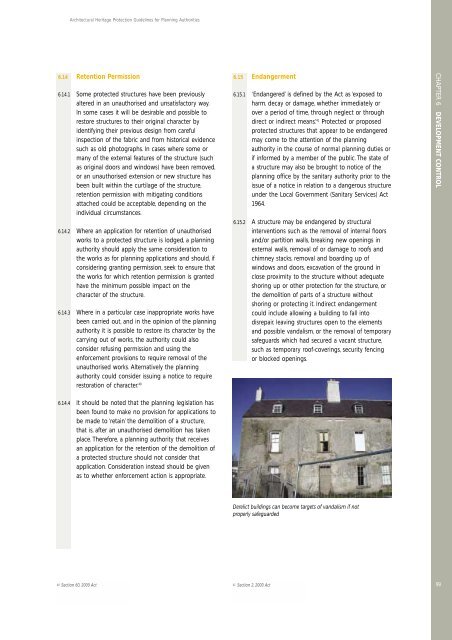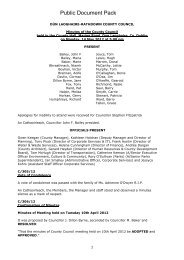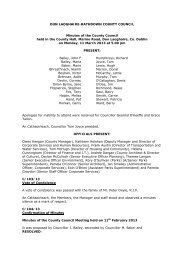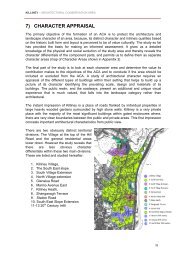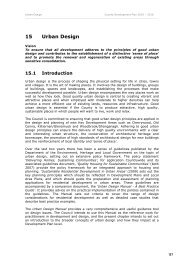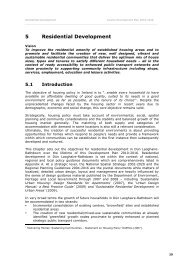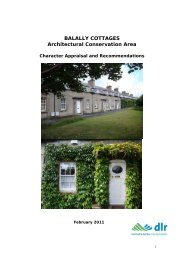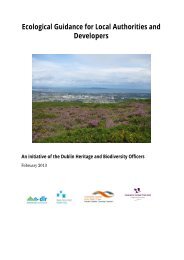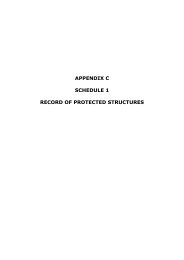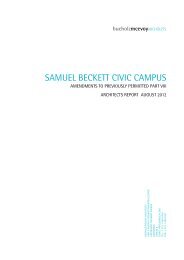Chapter 6 Development Control
Chapter 6 Development Control
Chapter 6 Development Control
- No tags were found...
You also want an ePaper? Increase the reach of your titles
YUMPU automatically turns print PDFs into web optimized ePapers that Google loves.
Architectural Heritage Protection Guidelines for Planning Authorities6.14 Retention Permission6.14.1 Some protected structures have been previouslyaltered in an unauthorised and unsatisfactory way.In some cases it will be desirable and possible torestore structures to their original character byidentifying their previous design from carefulinspection of the fabric and from historical evidencesuch as old photographs. In cases where some ormany of the external features of the structure (suchas original doors and windows) have been removed,or an unauthorised extension or new structure hasbeen built within the curtilage of the structure,retention permission with mitigating conditionsattached could be acceptable, depending on theindividual circumstances.6.14.2 Where an application for retention of unauthorisedworks to a protected structure is lodged, a planningauthority should apply the same consideration tothe works as for planning applications and should, ifconsidering granting permission, seek to ensure thatthe works for which retention permission is grantedhave the minimum possible impact on thecharacter of the structure.6.14.3 Where in a particular case inappropriate works havebeen carried out, and in the opinion of the planningauthority it is possible to restore its character by thecarrying out of works, the authority could alsoconsider refusing permission and using theenforcement provisions to require removal of theunauthorised works. Alternatively the planningauthority could consider issuing a notice to requirerestoration of character. 406.15 Endangerment6.15.1 ‘Endangered’ is defined by the Act as ‘exposed toharm, decay or damage, whether immediately orover a period of time, through neglect or throughdirect or indirect means’. 41 Protected or proposedprotected structures that appear to be endangeredmay come to the attention of the planningauthority in the course of normal planning duties orif informed by a member of the public. The state ofa structure may also be brought to notice of theplanning office by the sanitary authority prior to theissue of a notice in relation to a dangerous structureunder the Local Government (Sanitary Services) Act1964.6.15.2 A structure may be endangered by structuralinterventions such as the removal of internal floorsand/or partition walls, breaking new openings inexternal walls, removal of or damage to roofs andchimney stacks, removal and boarding up ofwindows and doors, excavation of the ground inclose proximity to the structure without adequateshoring up or other protection for the structure, orthe demolition of parts of a structure withoutshoring or protecting it. Indirect endangermentcould include allowing a building to fall intodisrepair, leaving structures open to the elementsand possible vandalism, or the removal of temporarysafeguards which had secured a vacant structure,such as temporary roof-coverings, security fencingor blocked openings.CHAPTER 6 DEVELOPMENT CONTROL6.14.4 It should be noted that the planning legislation hasbeen found to make no provision for applications tobe made to ‘retain’ the demolition of a structure,that is, after an unauthorised demolition has takenplace. Therefore, a planning authority that receivesan application for the retention of the demolition ofa protected structure should not consider thatapplication. Consideration instead should be givenas to whether enforcement action is appropriate.Derelict buildings can become targets of vandalism if notproperly safeguarded40 Section 60, 2000 Act 41 Section 2, 2000 Act99


